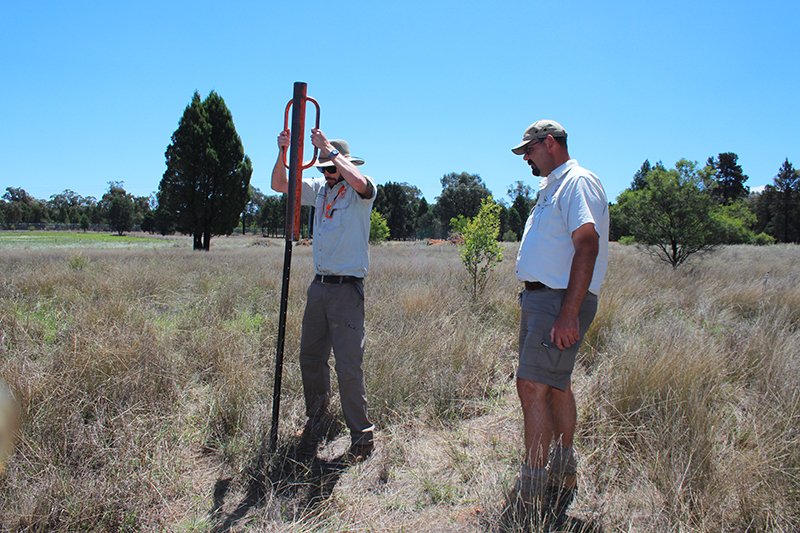The bilby is making a comeback in outback NSW

ONE HUNDRED years ago, had you wandered the red-dirt plains of Sturt National Park in the far north-west Corner Country of New South Wales, you’d have encountered the burrows of the greater bilby (Macrotis lagotis).
If your eye was in, you may well have spotted the den entrances on the desert floor or in dirt mounds – unless mulga scrub obscured them. The spiral-shaped hollows extended for up to 3m beneath the ground, cocooning the bilbies during daylight hours.
Today, the desert is a very different place. These marsupials are gone from Sturt. Due to introduced pests, habitat degradation and changes to fire-management practices after Aboriginal people were removed from their lands, Australia has suffered a wave of extinctions during the past 200 years. Experts believe more than 10 per cent of our 273 terrestrial mammal species has gone forever, with another 21 per cent currently threatened.

(Image Credit: Rick Stevens/Taronga Zoo)
In NSW, the loss of mammals that played important roles in desert ecosystems has had flow-on effects – a reduction in soil quality, the loss of further species and a less healthy environment.
To restore the balance, the University of NSW (UNSW) has partnered with ecological consultancy Ecological Horizons, in collaboration with Taronga Conservation Society Australia (TCSA) and the Office of Environment and Heritage, to create the Wild Deserts project, which aims to reintroduce mobs of locally extinct mammals to national parks such as Sturt – starting with the bilby.
“The greater bilby is a delicate but vital desert survivor. By digging for insects, seeds and plant roots it helps water and carbon infiltrate the soil, which, in turn, will trigger a restoration of Sturt NP’s desert ecosystems,” explains the project’s head, Professor Richard Kingsford, director of UNSW’s Centre for Ecosystem Science. “By restoring the native wildlife over the next 10 years, we will turn the desert around.”
The bilby – a type of bandicoot – is still found in isolated populations in other parts of arid Australia, including Western Australia, the Northern Territory and Queensland. It’s also found in several semi-wild, fenced sanctuaries, where conservation groups have made efforts to eradicate pests and encourage the growth of threatened flora and fauna.
As part of the Wild Deserts project, TCSA will release semi-wild bilbies from these sanctuaries into a 110ha facility at Taronga Western Plains Zoo near Dubbo in central west NSW.

(Image Credit: Paul Fahy/Taronga Zoo)
Once a viable population has been established, some of the offspring will be used to re-establish wild populations. “The purpose of our site is to breed them up and move them out,”says Andrew Elphinstone, the manager of TCSA Conservation and Recovery Programs. “We want to produce genetically appropriate, but also behaviourally appropriate, animals for release.
“Because these animals are going into the wild, we’re going to manage them in a wild-like fashion,” he continues. “They will find their own food and shelter, and they will choose their own mate. All the [regular] natural selection pressures will be influencing them…and the second and third generations of offspring will be the animals that we release.”
This isn’t the first time Taronga has reintroduced threatened species into the wild. In March 2017, as part of its Legacy Species program, TCSA released 300 corroboree frogs into large, disease-free enclosures in Kosciuszko National Park in southern NSW. And in April, 101 captive-bred regent honeyeaters were reintroduced to Victoria’s Chiltern-Mt Pilot National Park to boost the wild population of this critically endangered bird. At the Dubbo sanctuary site, Taronga also plans to breed endangered plains-wanderer birds and malleefowl for future release projects.

Andrew and zookeeper Steven Kleinig set up remote wildlife camera monitoring at the sanctuary site in Dubbo. In preparation for the arrival of the bilbies, fences are being upgraded on the site and pests removed. Once the bilbies have been moved in, the sanctuary will be closely monitored by the Taronga team. (Image Credit: Taronga Zoo)
“The beauty of this site is the huge range of expertise available on our doorstep,” Andrew says. “We have access to a wildlife hospital, a wildlife-conservation science division and decades of population-management and animal-husbandry experience.”
In preparation for the bilbies, the fencing around the sanctuary is being upgraded and foxes and feral cats removed. An initial mob of 10 bilbies will be introduced later this year and, by late 2019, Andrew hopes to have animals ready for ‘early release’ sites within Sturt NP. Managed by UNSW, these areas will undergo pest eradication and regular monitoring. Once the bilbies have adapted to the desert, they’ll be let loose into the wild.
The end goal is to produce enough bilbies to support other reintroduction projects around Australia – and then breed other locally extinct mammals, Andrew says. Right now, however, these “ecosystem engineers” are the top priority. “They do a lot of really important work, and, by putting a bilby population in first,” he says, “it will make it easier for other species to follow.”
READ MORE:
- 15-million-year-old bilby fossil found in Qld
- Carnivorous bilby fossil unearthed
- 10 reasons Australians should celebrate bilbies, not bunnies, this Easter




